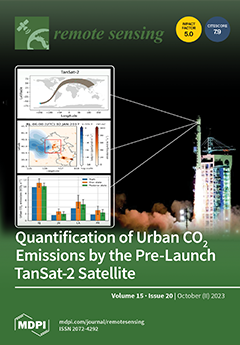Accurate global monitoring of carbon dioxide (CO
2) is essential for understanding climate change and informing policy decisions. This study compares column-averaged dry-air mole fractions of CO
2 (XCO
2) between ACOS_L2_Lite_FP V9r for Japan’s Greenhouse Gases Observing Satellite (GOSAT), OCO-2_L2_Lite_FP
[...] Read more.
Accurate global monitoring of carbon dioxide (CO
2) is essential for understanding climate change and informing policy decisions. This study compares column-averaged dry-air mole fractions of CO
2 (XCO
2) between ACOS_L2_Lite_FP V9r for Japan’s Greenhouse Gases Observing Satellite (GOSAT), OCO-2_L2_Lite_FP V10r for the USA’s Orbiting Carbon Observatory-2 (OCO-2), and IAPCAS V2.0 for China’s Carbon Dioxide Observation Satellite (TANSAT) collectively referred to as GOT, with data from the Total Carbon Column Observing Network (TCCON). Our findings are as follows: (1) Significant data quantity differences exist between OCO-2 and the other satellites, with OCO-2 boasting a data volume 100 times greater. GOT shows the highest data volume between 30–45°N and 20–30°S, but data availability is notably lower near the equator. (2) XCO
2 from GOT exhibits similar seasonal variations, with lower concentrations during June, July, and August (JJA) (402.72–403.74 ppm) and higher concentrations during December, January, and February (DJF) (405.74–407.14 ppm). XCO
2 levels are higher in the Northern Hemisphere during March, April, and May (MAM) and DJF, while slightly lower during JJA and September, October, and November (SON). (3) The differences in XCO
2 (ΔXCO
2) reveal that ΔXCO
2 between OCO-2 and TANSAT are minor (−0.47 ± 0.28 ppm), whereas the most significant difference is observed between GOSAT and TANSAT (−1.13 ± 0.15 ppm). Minimal differences are seen in SON (with the biggest difference between GOSAT and TANSAT: −0.84 ± 0.12 ppm), while notable differences occur in DJF (with the biggest difference between GOSAT and TANSAT: −1.43 ± 0.17 ppm). Regarding latitudinal variations, distinctions between OCO-2 and TANSAT are most pronounced in JJA and SON. (4) Compared to TCCON, XCO
2 from GOT exhibits relatively high determination coefficients (R
2 > 0.8), with GOSAT having the highest root mean square error (RMSE = 1.226 ppm, <1.5 ppm), indicating a strong relationship between ground-based observed and retrieved values. This research contributes significantly to our understanding of the spatial characteristics of global XCO
2. Furthermore, it offers insights that can inform the analysis of differences in the inversion of carbon sources and sinks within assimilation systems when incorporating XCO
2 data from satellite observations.
Full article





